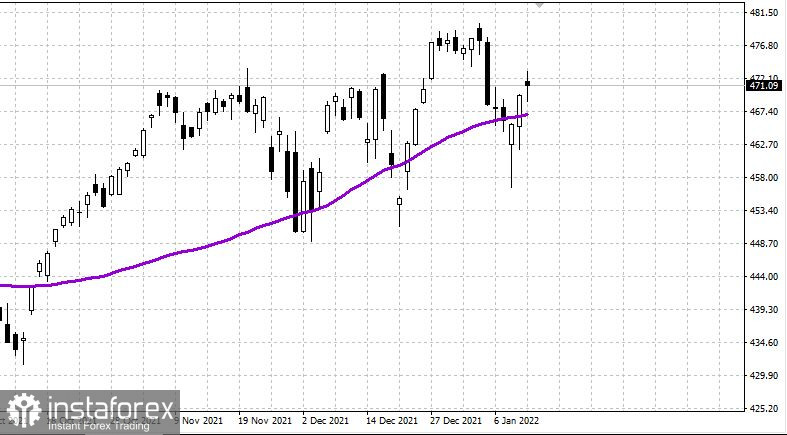
S&P500
The US market halted after two days of strong gains. Omicron hit a new high. The dollar declined.
On Wednesday, the US market halted after two days of strong gains: the Dow rose by 0.1%, the NASDAQ went up 0.2%, and the S&P 500 gained 0.3%.
Headline news: The number of Omicron infections have increased significantly. Omicron hit a new high as 3.2 million new cases of this variant were detected in 24 hours globally. The US recorded 830,000 coronavirus cases yesterday. The number of new infections in India increased by 240,000 yesterday. Italy and Spain recorded 180,00 and 200,000 new cases respectively. The only upside is that deaths remain at relatively low pre-omicron levels. However, the US recorded 2,200 deaths yesterday. The US hospital system is under tremendous strain.
Asian markets declined sharply on Thursday morning. Japan's indices went down 1%, China's indices sank 1.4%, while the S&P500 futures predict the US market's decline by 0.2% at the start of trading today.
Energy: Brent crude oil rose to $85 yesterday. This value is only $1.7 below last year's highs, which hit 5-year highs at the same time. Brent crude oil is slightly down this morning as it is trading at $84.40.
S&P500 4726, the range is 4700 - 4750
Wednesday's key event was the new US inflation report for December. The report showed that inflation remained at a record 30-year high, rising by 7% per year. Besides, there were signs of price growth fatigue. The prices have mostly slowed, except for fuel and transportation services. The lack of new increase in inflation together with Fed Chairman Powell's dovish statements in the US Senate the day before probably led to a drop in the dollar. Moreover, experts expect a Fed rate hike as early as March.
The US core inflation except for gasoline and food prices rose by 5.5% year-on-year.
Some analysts mentioned a drop in US oil inventories. They declined by 4.5 million barrels over the week. However, analysts did not note that gasoline inventories had risen by 7.9 million barrels. Therefore, there is no fuel shortage in the US.
Analysts compare current high US inflation to high inflation in the early 1980s. At that time, skyrocketing oil prices were the reason for high inflation. In the early 1980s, the Federal Reserve sharply increased interest rates. They were rising as fast as inflation and reached a whopping 16% per year. The price of beating inflation was a downturn in the economy and a rise in unemployment to 10%. Powell and the Fed are not willing to have the same bad experience and will try to take special measures. However, only time will tell if they succeed.
On Wednesday, the Fed's Beige Book concerning the US economy was published. Traditionally, it was released exactly 2 weeks before the new Fed meeting. The report showed solid economic growth, however noted a slowdown in both production and demand and price growth. Besides, there are concerns about supply and workers due to the Omicron variant.
USDX 95.00, the range is 94.70 - 95.30. The dollar fell by 0.6% yesterday according to the dollar index. At the same time, the EUR/USD pair rose sharply to 1.1440 and thereby exited the range it had been in since mid-November. The dollar's decline is obviously corrective in nature as it will inevitably rise again with a new tightening of the Federal Reserve policy.
USD/CAD 1.2500, the range is 1.2400 - 1.2560. The pair continued falling both on the US dollar's decline and on the new rise in oil. The drop will continue so far.
Conclusion: The US market is ready for a new wave of decline. The growth in new Omicron cases in the US continues, inflation is at a high level. Besides, there is no reason for a big growth of the US market, and the probability of a decline is higher than an increase.`
 English
English 
 Русский
Русский Bahasa Indonesia
Bahasa Indonesia Bahasa Malay
Bahasa Malay ไทย
ไทย Español
Español Deutsch
Deutsch Български
Български Français
Français Tiếng Việt
Tiếng Việt 中文
中文 বাংলা
বাংলা हिन्दी
हिन्दी Čeština
Čeština Українська
Українська Română
Română

